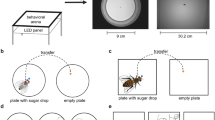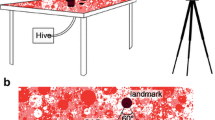Abstract
Honeybees returning from foraging trips were video-filmed while they walked through a narrow transparent gangway to reach the hive entrance. On their way they were presented with black-and-white gratings viewed underneath as well as to both sides of the gangway. Bees could exit the gangway through one of two or three side exits installed at different distances from the gangway entrance. In one set of experiments, the substrate on which the bees walked was moved either in the bee's direction or against it. In another set of experiments, the substrate was stationary, but the pattern was moved in one or the other direction. The bee's walking speed (WS) was evaluated from the video tapes. When the substrate moved against, or the pattern in the bee's direction, in either case decreasing the speed of pattern flow (PFS), the bees increased WS, and, at the same time, they preferred the more distant exit. When the substrate moved in, or the pattern against the bee's direction, thus increasing PFS, WS decreased and the bees preferred the nearer exit. These results suggest that the speed of optic flow controls the speed of locomotion and might therefore also serve for assessing the distance travelled.
Similar content being viewed by others
Abbreviations
- PFS :
-
pattern-flow speed
- WS :
-
walking speed
References
Esch HE, Burns JE (1996) Distance estimation by foraging honeybees. J Exp Biol 199: 155–162
Esch HE, Goller F, Burns JE (1994) Honeybees waggle dances: the “energy hypothesis” and thermoregulatory behavior of foragers. J Comp Physiol B 163: 621–625
Frisch Kv (1967) The dance language and orientation of bees. Harvard Univ Press, Cambridge Mass
Görner P, Class B (1985) Homing behavior and orientation of the funnel-web spider Agelena labyrinthica Clerck. In: Barth FG (ed) Neurobiology of archanids. Springer, Berlin Heidelberg New York, pp 275–297
Götz KG, Wenking H (1973) Visual control of locomotion in the walking fruitfly Drosophila. J Comp Physiol 85: 235–266
Heran H (1956) Ein Beitrag zur Frage nach der Wahrnehmungsgrundlage der Entfernungsweisung der Bienen. Z Vergl Physiol 38: 168–218
Kennedy JS, Marsh D (1974) Pheromone-regulated anemotaxis in flying moths. Science 184: 999–1001
Lehrer M (1996) Small-scale navigation in the honeybee — active acquisition of visual information about the goal. J Exp Biol 199: 253–261
Lehrer M, Srinivasan MV (1992) Freely flying bees discriminate between stationary and moving objects: Performance and possible mechanisms. J Comp Physiol A 171: 457–467
Lehrer M, Srinivasan MV (1993) Object detection by honeybees: why do they land on edges? J Comp Physiol A 173: 23–32
Mittelstaedt H (1985) Analytical cybernetics of spider navigation. In: Barth FG (ed) Neurobiology of arachnids. Springer, Berlin Heidelberg New York, pp 298–316
Mittelstaedt ML, Glasauer S (1991) Idiothetic navigation in gerbils and humans. Zool Jb Physiol 95: 427–435
Moller P, Görner P (1994) Homing by path integration in the spider Agelena labyrinthica Clerck. J Comp Physiol A 174: 221–229
Preiss R, Kramer E (1983) Stabilisation of altitude and speed in thethered flying gypsy moth males: influence of (+) and (-)-disparlure. Physiol Entomol 8: 55–68
Ronacher BD, Wehner R (1995) Desert ants Cataglyphis fortis use self-induced optic flow to measure distance travelled. J Comp Physiol A 177: 21–27
Schäfer M, Wehner R (1993) Loading does not affect measurement of walking distance in desert ants. Cataglyphis fortis. Verh Dt Zool Ges 86: 270
Schöne H (1984) Spatial orientation. Princeton Univ Press, Princeton N.J.
Srinivasan MV, Lehrer M, Kirchner W,Zhang SW (1991) Range perception through apparent image speed in freely flying honeybees. Visual Neurosci 6: 519–536
Srinivasan MV, Zhang SW, Lehrer M, Collett TS (1996) Honeybee navigation enroute to the goal — visual flight control and odometry. J Exp Biol 199: 237–244
Wehner R (1981) Spatial vision in arthropopds. In: Autrum H (ed) Vision in Invertebrates. Hdb Sens Physiol VII/6C. Springer, Berlin Heidelberg New York, pp 287–616
Wehner R (1992) Arthropods. In: Papi F (ed) Animal homing. Chapman & Hall, London, pp 45–144
Wehner R, Srinivasan MV (1981) Searching behaviour of desert ants, genus Cataglyphis (Formicidaer, Hymenoptera). J Comp Physiol 142: 315–338
Wehner R, Wehner S (1986) Path integration in desert ants, approaching a long-standing puzzle in insect navigation. Monitore Zool Ital (NS) 20: 309–331
Wehner R, Michel B, Antonsen P (1996) Visual navigation in insects — coupling of egocentric and geocentric information. J Exp Biol 199: 129–140
Zanker JM, Collett TS (1985) The optomotor system on the ground: on the absence of visual control of speed in walking ladybirds. J Comp Physiol A 156: 395–402
Zollikofer CPE (1994) Stepping patterns in ants. I. Influence of speed and curvature. J Exp Biol 192: 95–106
Author information
Authors and Affiliations
Additional information
Dedicated to Hans-Jochen Autrum, editor emeritus, for help in giving birth to this and many other papers over very many years, often with criticism but nevertheless with encouragement and sympathy.
Rights and permissions
About this article
Cite this article
Schöne, H. Optokinetic speed control and estimation of travel distance in walking honeybees. J Comp Physiol A 179, 587–592 (1996). https://doi.org/10.1007/BF00192324
Accepted:
Issue Date:
DOI: https://doi.org/10.1007/BF00192324




